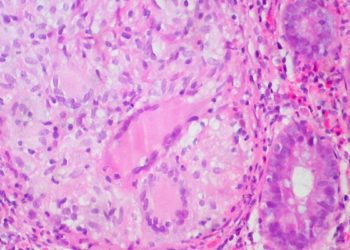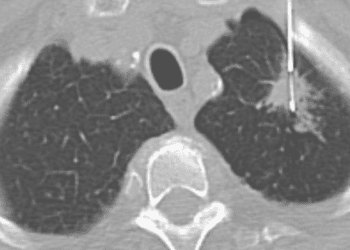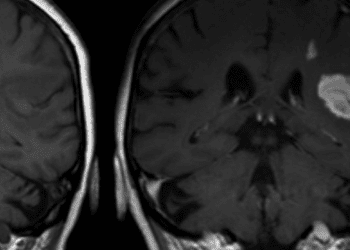2 Minute Medicine Rewind October 28, 2024
Pharmacologic Treatments for Dementia and the Risk of Developing Age-Related Macular Degeneration
1. The use of memantine and donepezil for treatment of patients with dementia were not associated with increased or decreased risks of developing age-related macular degeneration (AMD).
Evidence Rating Level: 2 (Good)
A large body of evidence has been reported describing associations between dementia and several age-related ocular diseases including AMD, the leading cause of blindness in individuals aged 50 or older. Some studies have suggested that the dementia medications memantine and donepezil may have protective associations with the risk of developing AMD, but further investigation is needed to confirm these results. This population-based cohort study therefore sought to investigate whether donepezil or memantime are associated with lower risks of developing AMD in patients with dementia compared to other dementia medications. 3 different cohorts of patients aged 40 or older with pre-exsting dementia from the UK were created, with cohort 1 comparing the risk of AMD in patients receiving donepezil versus rivastigmine or galantamine and cohort 2 comparing the risk of AMD in patients receiving memantine versus rivastigmine, galantamine or donepezil. Cohort 3 was the same as cohort 2 but omitted patients receiving donepezil as part of a sensitivity analysis. No significant difference was found in the risk of developing AMD for patients receiving donepezil compared to rivastigmine or galantamine (adjusted HR, 0.95 [95% CI 0.67-1.35]). Similarly, no significant difference was found in the risk of developing AMD for patients receiving memantine compared to rivastigmine, galantamine or donepezil (adjusted HR, 1.03 [95% CI, 0.83-1.27]). Results of the sensitivity analysis showed similar results to that of cohort 2, with an adjusted HR of 1.24 (95% CI, 0.83-1.86) in the exposed group (memantine). Overall, this study found that the dementia medications memantine and donepezil did not have protective or harmful associations with the risk of developing AMD in patients with dementia.
Nurse Telephone Support for Caregivers of Older Adults at Hospital Discharge
1. A nurse telephone support intervention, Further Enabling Care at Home (FECH+), did not significantly improve the health-related quality of life (HRQOL) of caregivers of older adult patients 6 months after hospital discharge compared to traditional forms of care.
2. At 6 months after hospital discharge, caregivers of older adult patients receiving FECH+ experienced increased preparedness to care and self-efficacy compared to those receiving traditional forms of care.
Evidence Rating Level: 1 (Excellent)
With growing elderly populations around the world, methods of improving the HRQOL of caregivers of older adult patients is becoming increasingly important. Caregivers of older adult patients have often reported feeling high levels of stress as well as feeling unprepared and overwhelmed in their duties. This study therefore sought to evaluate the efficacy of FECH+ in improving the HRQOL of caregivers of older adult patients at 6 months post-hospital discharge. Participants were recruited as dyads of patients aged 70 years and older and their unpaid caregivers from various hospitals in Australia, and randomized to either an intervention or control group. Caregivers in the intervention group received the FECH+ program, consisting of 6 periodic telephone calls from a nurse, as well as traditional discharge care. The primary outcome was the caregiver’s HRQOL at 6 months as measured by the Assessment of Quality of Life 8-Dimension (AQOL-8D). 547 caregivers (mean [SD] age, 64.50 [12.82] years; 74.0% female) and 547 patients (mean [SD] age, 83.16 [7.04] years for the intervention group, 83.45 [7.20] years for the control group; 54.1% female) were included in the study. At 6 months post-discharge, the intervention group demonstrated an increase in HRQOL compared to the control group but no statistically significant difference was found (between-group difference in AQOL-8D score, 0.01; 95% CI, −0.02 to 0.03; P = .62). At 6 months, the intervention group demonstrated a statistically significant increase in preparedness to care (mean difference, 0.19; 95% CI, 0.06-0.31; P = .003) as well as self-efficacy (mean difference, 4.49; 95% CI, 0.29-8.69; P = .04). Overall, this study found that the use of FECH+, a nurse telephone support intervention, for caregivers of older adult patients after hospital discharge did not result in significant changes in HRQOL compared to control but did result in improved preparedness to care and self-efficacy.
1. The combination of the anti-Dickkopf-related protein 1 (DKK1) antibody, DKN-01, with frontline fluoropyrimidine/oxaliplatin and tislelizumab in patients with advanced gastric or gastroesophageal junction adenocarcinomas was safe and tolerable.
Evidence Rating Level: 1 (Excellent)
Preclinical models of gastroesophageal adenocarcinomas (GEAs), an important cause of cancer-related mortality, have shown that DKK1 blockade improves the efficacy of anti-PD1 treatment for these malignancies. This randomized phase IIa open-label trial therefore sought to investigate the safety, tolerability and efficacy of the addition of the anti-DKK1 antibody, DKN-01, with the anti-PD1 antibody tislelizumab and fluoropyrimidine/oxaliplatin chemotherapy treatment in patients with advanced GEAs. Patients were included on the basis of having human epidermal growth factor 2 (HER2) negative-GEA and not having received systemic treatment in the locally advanced or metastatic setting. All patients received intravenous DKN-01, tislelizumab, oxaliplatin and oral capecitabine. The study’s primary safety endpoint included, among others, the incidence of treatment-emergent adverse events (TEAEs) and grade ≥3 TEAEs. Efficacy endpoints included the objective response rate (ORR), progression-free survival (PFS) and disease control rate (DCR). 25 patients (median age, 61.0 years; 76% male) were included in the study. All patients experienced at least one TEAE, 96% of which were attributed to capecitabine and oxaliplatin (CAPOX) chemotherapy. 6 patients experienced grade ≥3 TEAEs related to DKN-01, with two patients experiecing discontinuation related to DKN-01 and one patient experiencing a TEAE leading to death related to DKN-01. In the modified intention-to-treat group which received at least 1 dose of DKN-01 (22 patients), the ORR was 73% (95% CI, 49.8 to 89.3) and 90% (95% CI, 55.5 to 99.7) in patients whose tumours were DKN-01 high (n = 10). Overall, the addition of DKN-01 to tislelizumab and CAPOX was safe and tolerable, being consistent with expected adverse effects observed in previous clinical trials of platinum-based chemotherapy and anti-PD1 therapy in GEAs.
GLP-1 Receptor Agonists Confer No Increased Rates of IBD Exacerbation Among Patients With IBD
1. The use of glucagon-like peptide 1 (GLP-1) agonists in patients with inflammatory bowel disease (IBD) was associated with few episodes of disease exacerbation and resulted in a significant decrease in BMI 1 year following initiation.
Evidence Rating Level: 2 (Good)
Recent evidence has suggested that obesity may be associated with worse outcomes in IBD, such as decreased responsiveness to IBD therapies. GLP-1 agonists are novel agents originally approved for the management of type 2 diabetes mellitus, which have also demonstrated weight-lowering benefits in other patients. However, the safety of GLP-1 agonists in patients with IBD has not been well characterized. This observational study therefore sought to investigate the safety and effectiveness of GLP-1 agonists on weight loss in IBD patients. 224 patients with IBD (median age, 54 years; 36.6% male) who were utilizing GLP-1 receptor agonists were identified from the NYU Langone Health system. The primary outcome of the study was IBD exacerbation 1 year following GLP-1 receptor agonist prescription, while the efficacy of GLP-1 receptor agonists was measured by comparing BMI values between IBD patients and non-IBD controls. At 1 year prior to initiation of GLP-1 receptor agonist therapy, 34.4% of patients had an IBD exacerbation compared to 30.4% 1 year after initiation of GLP-1 receptor agonist. There was no significant difference in the rate of exacerbation before and after initiation of GLP-1 receptor agonist (P = .36). Among IBD patients, there was a significant decrease in BMI 1 year after GLP-1 receptor agonist initiation (median BMI decrease from 33.5-31.6 kg/m2; P = <0.01). A significant change in BMI was also observed in non-IBD patients (median BMI decrease 36.1-34.4 kg/m2, P < .01); however, significant changes were observed in the levels of cholesterol, LDL and HDL among IBD patients which were not observed in controls. Overall, this study found that GLP-1 receptor agonists were not associated with increased rates of disease exacerbation in IBD patients and are effective in decreasing BMI.
1. The use of glucagon-like peptide 1 (GLP-1) receptor agonists in adults with type 2 diabetes mellitus (T2DM) was not associated with increased risks of pulmonary aspiration during upper gastrointestinal endoscopy discontinuation compared to the use of sodium-glucose cotransporter 2 (SGLT-2) inhibitors.
2. The use of GLP-1 receptor agonists among adults with T2DM was associated with greater risks of upper gastrointestinal endoscopy discontinuation compared to the use of SGLT-2 inhibitors.
Evidence Rating Level: 2 (Good)
Recent studies have reported pulmonary aspiration or retained gastric contents with patients using GLP-1 receptor agonists undergoing upper gastrointestinal endoscopy which have led to concerns surrounding their discontinuation prior to elective procedures. However, further evidence is needed to better characterize risks associated with GLP-1 receptor agonists in patients undergoing such procedures. This nationwide cohort study therefore sought to investigate the risk of pulmonary aspiration and endoscopy discontinuation associated with the use of GLP-1 receptor agonist prior to procedure compared to other antidiabetic drugs in patients undergoing upper endoscopy. Adult patients with T2DM who underwent upper endoscopy between January 1st, 2016 and December 31st, 2021 were identified from two nationwide databases (MarketScan Commercial Claims and Encounters, and Optum Clinformatics Data Mart). The primary outcome was pulmonary aspiration on the day of or the day following upper endoscopy, while the secondary outcome was endoscopy discontinuation. 24,824 individuals who underwent upper endoscopy and used a GLP-1 receptor agonist within 30 days prior were identified, and 18,541 individuals who underwent the same procedure and used an SGLT-2 inhibitor within 30 days prior were identified. Compared to individuals using SGLT-2 inhibitor, the use of GLP-1 receptor agonist was not associated with increased risks of pulmonary aspiration (weighted risk 4.15 v 4.26 per 1000 people, respectively; pooled risk ratio 0.98, 95% CI 0.73 to 1.31). However, the use of GLP-1 receptor agonist was associated with increased risks of endoscopy discontinuation compared to the use of SGLT-2 inhibitor (9.79 v 4.91 per 1000 people; pooled risk ratio 1.99, 1.56 to 2.53). Overall, this study found that the use of GLP-1 receptor agonist in patients with T2DM prior to upper endoscopy was not associated with increased risks of pulmonary aspiration compared to the use of SGLT-2 inhibitors, but was associated with increased risks of endoscopy discontinuation.
Image: PD
©2024 2 Minute Medicine, Inc. All rights reserved. No works may be reproduced without expressed written consent from 2 Minute Medicine, Inc. Inquire about licensing here. No article should be construed as medical advice and is not intended as such by the authors or by 2 Minute Medicine, Inc.







